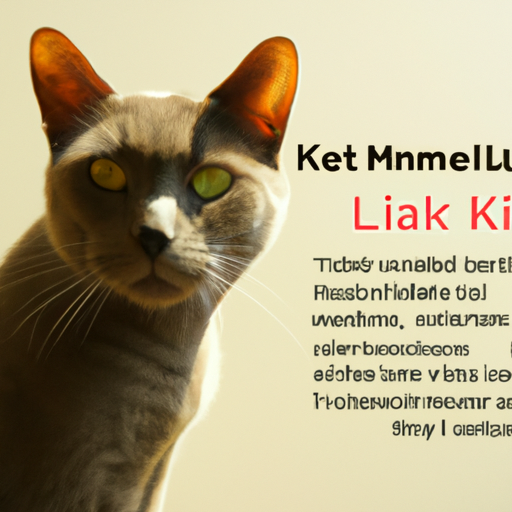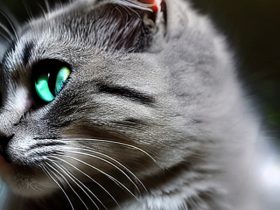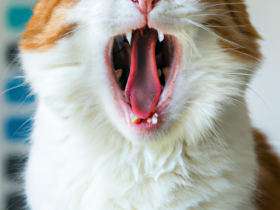“Protect Your Cat: Learn About Feline Leukemia and How to Prevent It!”
Introduction
Feline Leukemia is a serious and potentially fatal virus that affects cats. It is caused by the feline leukemia virus (FeLV) and is one of the most common infectious diseases in cats. It is highly contagious and can be spread through contact with an infected cat’s saliva, urine, feces, or blood. It can also be spread through shared food and water bowls, litter boxes, and grooming tools. Symptoms of feline leukemia can include fever, loss of appetite, weight loss, pale gums, and anemia. If left untreated, the virus can cause serious health problems, including cancer and organ failure. Fortunately, there are steps that can be taken to help prevent the spread of feline leukemia. Vaccination is the most effective way to protect cats from the virus, and regular veterinary check-ups can help detect the virus early. Additionally, avoiding contact with stray cats and keeping cats indoors can help reduce the risk of infection. By understanding feline leukemia and taking the necessary steps to prevent it, cat owners can help keep their cats healthy and safe.
What is Feline Leukemia and How Can You Identify It?
Feline Leukemia (FeLV) is a virus that affects cats and is one of the leading causes of death in cats. It is a contagious virus that is spread through contact with saliva, nasal secretions, and urine of an infected cat. FeLV can also be spread through shared food and water bowls, litter boxes, and grooming tools.
The virus can cause a variety of health problems, including anemia, cancer, and a weakened immune system. Symptoms of FeLV can vary from cat to cat, but may include weight loss, poor coat condition, fever, lethargy, and diarrhea.
The only way to definitively diagnose FeLV is through a blood test. This test looks for the presence of the virus in the cat’s blood. If the test is positive, the cat is considered to be infected with FeLV.
It is important to note that not all cats that test positive for FeLV will develop the disease. Some cats may be able to fight off the virus and remain healthy. However, cats that are infected with FeLV are more likely to develop serious health problems and should be monitored closely by a veterinarian.
In order to prevent the spread of FeLV, it is important to keep cats that are infected with the virus separated from other cats. Vaccines are also available to help protect cats from the virus.
How to Reduce the Risk of Feline Leukemia in Your Cat
Feline leukemia is a serious and potentially fatal virus that can affect cats of all ages. Fortunately, there are steps that can be taken to reduce the risk of your cat contracting this virus.
The first step is to ensure that your cat is vaccinated against the virus. Vaccines are available from your veterinarian and should be administered according to their instructions. Vaccines are not 100% effective, but they can significantly reduce the risk of your cat contracting the virus.
The second step is to keep your cat indoors. Cats that are allowed to roam outdoors are at a much higher risk of contracting the virus from other cats. Keeping your cat indoors will reduce the risk of exposure to the virus.
The third step is to keep your cat away from other cats that may be infected with the virus. If you must bring your cat into contact with other cats, make sure that they are healthy and have been vaccinated against the virus.
Finally, it is important to practice good hygiene when handling your cat. Wash your hands before and after handling your cat, and avoid contact with cats that may be infected with the virus.
By following these steps, you can reduce the risk of your cat contracting feline leukemia. However, it is important to remember that there is no guarantee that your cat will not contract the virus. If you have any concerns, it is best to consult your veterinarian.
The Benefits of Vaccinating Your Cat Against Feline Leukemia
Vaccinating your cat against feline leukemia is an important step in protecting your pet’s health. Feline leukemia is a serious and potentially fatal virus that can be spread through contact with other cats, as well as through contact with infected bodily fluids. Vaccination is the best way to protect your cat from this virus.
The first benefit of vaccinating your cat against feline leukemia is that it can help to prevent the virus from spreading. Vaccination helps to create a barrier between your cat and other cats that may be infected. This can help to reduce the risk of your cat becoming infected, as well as reducing the risk of other cats becoming infected.
The second benefit of vaccinating your cat against feline leukemia is that it can help to reduce the severity of the virus if your cat does become infected. Vaccination can help to reduce the severity of the symptoms and can help to reduce the risk of death. Vaccination can also help to reduce the risk of your cat passing the virus on to other cats.
The third benefit of vaccinating your cat against feline leukemia is that it can help to reduce the cost of treatment if your cat does become infected. Vaccination can help to reduce the severity of the symptoms, which can help to reduce the cost of treatment. Vaccination can also help to reduce the risk of your cat passing the virus on to other cats, which can help to reduce the cost of treatment for those cats as well.
Vaccinating your cat against feline leukemia is an important step in protecting your pet’s health. Vaccination can help to reduce the risk of your cat becoming infected, as well as reducing the severity of the virus if your cat does become infected. Vaccination can also help to reduce the cost of treatment if your cat does become infected. Taking the time to vaccinate your cat against feline leukemia can help to ensure that your pet remains healthy and safe.
Understanding the Symptoms of Feline Leukemia and How to Treat It
Feline leukemia is a serious and potentially fatal disease caused by the feline leukemia virus (FeLV). It is one of the most common infectious diseases in cats and is highly contagious. It is estimated that 2-3% of cats in the United States are infected with FeLV.
The symptoms of feline leukemia can vary depending on the stage of the disease. In the early stages, cats may show no signs of illness. As the disease progresses, cats may experience a variety of symptoms, including fever, loss of appetite, weight loss, lethargy, pale gums, enlarged lymph nodes, and eye and skin lesions. In some cases, cats may also develop anemia, respiratory problems, and neurological symptoms.
Treatment for feline leukemia is aimed at controlling the symptoms and preventing the spread of the virus. Treatment may include antibiotics to treat secondary infections, anti-inflammatory medications to reduce inflammation, and antiviral medications to reduce the replication of the virus. In some cases, cats may also require blood transfusions or other supportive care.
It is important to note that there is no cure for feline leukemia. However, with proper treatment and care, cats can live a long and healthy life. It is also important to keep cats away from other cats that may be infected with the virus. Vaccination is the best way to prevent the spread of the virus.
In conclusion, feline leukemia is a serious and potentially fatal disease caused by the feline leukemia virus. Symptoms can vary depending on the stage of the disease and may include fever, loss of appetite, weight loss, lethargy, pale gums, enlarged lymph nodes, and eye and skin lesions. Treatment is aimed at controlling the symptoms and preventing the spread of the virus. There is no cure for feline leukemia, but with proper treatment and care, cats can live a long and healthy life. Vaccination is the best way to prevent the spread of the virus.
How to Create a Safe Environment for Cats with Feline Leukemia
Feline Leukemia (FeLV) is a serious and contagious virus that affects cats. It is important to create a safe environment for cats with FeLV to ensure their health and wellbeing. Here are some tips for creating a safe environment for cats with FeLV:
1. Vaccinate all cats in the household: Vaccinating all cats in the household is the best way to protect cats with FeLV from contracting other illnesses. Vaccines can help reduce the risk of infection and can help cats with FeLV live longer, healthier lives.
2. Keep cats indoors: Keeping cats with FeLV indoors can help protect them from other cats that may be carrying the virus. It is also important to keep cats with FeLV away from other cats that may be carrying the virus, as FeLV is highly contagious.
3. Provide a clean environment: Cats with FeLV are more susceptible to infections, so it is important to keep their environment clean. Regularly clean and disinfect litter boxes, bedding, and other areas where cats may come into contact with the virus.
4. Provide a healthy diet: Cats with FeLV are more prone to developing health problems, so it is important to provide them with a healthy diet. Feed cats with FeLV a balanced diet that is high in protein and low in fat.
5. Monitor cats for signs of illness: Cats with FeLV are more prone to developing illnesses, so it is important to monitor them for signs of illness. If cats with FeLV show signs of illness, such as fever, lethargy, or loss of appetite, it is important to take them to the vet for a checkup.
By following these tips, you can create a safe environment for cats with FeLV and help them live longer, healthier lives.
Q&A
Q1: What is feline leukemia?
A1: Feline leukemia is a virus that affects cats and can cause a variety of health problems, including anemia, cancer, and immune system suppression.
Q2: How is feline leukemia spread?
A2: Feline leukemia is spread through contact with an infected cat’s saliva, urine, or feces. It can also be spread through shared food and water bowls, grooming tools, and bedding.
Q3: What are the symptoms of feline leukemia?
A3: Symptoms of feline leukemia can include fever, loss of appetite, weight loss, pale gums, and swollen lymph nodes.
Q4: How can I prevent my cat from getting feline leukemia?
A4: The best way to prevent your cat from getting feline leukemia is to keep them indoors and away from other cats that may be infected. Vaccinating your cat against the virus is also recommended.
Q5: What should I do if I think my cat has feline leukemia?
A5: If you think your cat has feline leukemia, it is important to take them to the vet as soon as possible. Your vet will be able to diagnose the virus and provide treatment options.
Conclusion
In conclusion, understanding feline leukemia and how to prevent it is essential for all cat owners. Vaccination is the best way to protect cats from this disease, and it is important to keep cats indoors and away from other cats that may be infected. Additionally, regular veterinary check-ups and testing can help to detect the disease early and provide the best chance for successful treatment. By taking these steps, cat owners can help to ensure their cats remain healthy and safe from feline leukemia.








Leave a Reply
View Comments